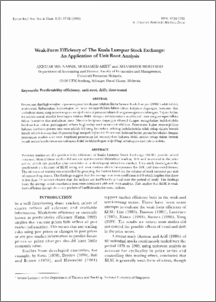Citation
Md. Nassir, Annuar and Ariff, Mohamed and Mohamad, Shamsher
(1993)
Weak-Form Efficiency of The Kuala Lumpur Stock Exchange:
An Application of Unit Root Analysis.
Pertanika Journal of Social Sciences & Humanities, 1 (1).
pp. 57-62.
ISSN 0128-7702
Abstract
Previous studies on the predictability efficiency of Kuala Lumpur Stock Exchange (KLSE) provide mixed
evidence. Most of these studies did not altemptto control thinness of trading, drift and time-trend in the price
series, which are peculiar characteristics of a developing securities market. This study investigates the
predictability efficiency of KLSE using unit root analysis which incorporates the drift and time-trend factors.
The thinness of trading was controlled by grouping the indices based on the volume of stock turnover per unit
of outstanding shares. The findings suggest that the average unit root coefficient is 0.9 which implies that there
is less than 10 percen t chance that the indices are inefficiently priced over the period of study. The findings
from the average serial correlation tests were consistent with unit root analysis. This implies that KLSE is weakform
efficient though there are pockets of inefficiencies for some indices.
Download File
![[img]](http://psasir.upm.edu.my/style/images/fileicons/application_pdf.png)  Preview |
|
PDF
Weak-Form_Efficiency_of_The_Kuala_Lumpur_Stock_Exchange.pdf
Download (2MB)
|
|
Additional Metadata
Actions (login required)
 |
View Item |

